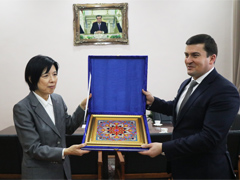January 17, 2023
Last year, on the 7th of December, I traveled to Tajikistan where the 1st JICA Chair Lecture on "Educational Development in a Modernizing Japan" was being held. Around 300 students and academic staff from the Tajik National University, the Tajik State University of Finance and Economics, and other universities gathered in the Tajik National University to eagerly attend my lecture. This was despite the numbingly cold weather that day, typical of landlocked countries, with the first snowfall two days earlier.

JICA Chair Lecturer: Dr. KAYASHIMA N. Senior Research Advisor for the JICA Ogata Sadako Research Institute for Peace and Development

Tajik National University Campus
During the lecture, after showing a video on "Educational Development in Modernization in Japan," I covered 3 requested topics: "Changes in Tradition/Culture/Sense of Values in Educational Development in Japan," "Transitions in Education for Women," and "The Internationalization of Higher Education." For the first topic, "Tradition/Culture/Sense of Values," I pointed out that in the early stages of its introduction, the westernized orientation of modern education in Japan clashed with the sense of value of returning to traditional Confucianism. Meanwhile, the emphasis on the introduction of science and technology, symbolized by the words Wakon Yosai (Japanese spirit with Western learning), was remarkable. But at the same time, I also explained that if we look back over the 150-year history of modern education in Japan, we can see that a new school culture has gradually emerged as a mixture of change and no change.
The Tajiks are said to have the longest history in all Central Asia. Around the 8th century, they were Islamized, and in the early 20th century, they were incorporated into the Soviet Union with the establishment of the Tajik Autonomous Soviet Socialist Republic. Today, the more interesting aspect of modern education in Tajikistan is how Islamic traditions and values have changed under the socialist system, even though there are many Tajiks today who are flexible followers of Islam. I did not have enough time to explore the history of education in Tajikistan this time, but I definitely want to learn more on the subject in the future.

Female Tajik students learning Japanese
For the second topic—"The History of Education for Women," I showed the transition in education for women in the Meiji period and the Post-war period in Japan. I explained that education for women developed in relation to educational policies, the recognition of women's roles in society, and their entry into the labor market. For example, when secondary education for women rapidly expanded in the later Meiji period, it was with the aim of developing dutiful wives and devoted mothers. Higher education for women began to gain popularity after the war, but it was the popularity of women's junior colleges that increased at that time. The number of women entering 4-year university programs exceeded those entering junior colleges around the mid-90s when the M-shaped curve of women's labor force participation improved in Japan.
There were many Tajik female students in attendance at the lecture and they asked about the state of women's universities and colleges in Japan. Although Tajikistan had a wide gender gap in higher education in the 2000s—with male enrollment at 25% and female enrollment at 11%—, the number of women attending university has since increased. More recent data from 2017 suggests that the gap is reducing, with male at 35% and female at 27%. One thing that surprised me during this visit to Tajikistan was when I visited a Japanese class and met a female student who had recently become a mother. In Tajikistan it is not uncommon for students to get married and give birth while still in school (the average age of first marriage for Tajik women was 21 in 2017). It brought me joy to see a female Tajik student who could excitedly study at a university while having an arranged marriage, giving birth, and raising children in their 20s.
The third topic was "The Internationalization of Higher Education in Japan." Since I wanted top-class Tajik youth to consider studying abroad in Japan, the bulk of my presentation was on topics such as Japan's policies on international students, international student education in English, the internationalization of universities in Japan, and the utilization of ICT that was rapidly normalized during the COVID-19 pandemic. The students in attendance asked many specific questions about studying in Japan, and I believe there was a high-level of interest in the country. The academic staff in the front row made a comment about how it is important to participate in the international academic network through student mobility and collaborative research.
Most Tajik international students study in Russia. According to UNESCO data for 2019, 21,973 students from Tajikistan studied in Russia, accounting for 80% of the total number of outgoing students, while only 52 students studied in Japan. Russian is positioned as a second national language, so to speak, rather than a foreign language, and is understood by a large part of the population, with 18% of university students receiving their education in Russian (2011/12). In addition, when we hear that remittances from migrant workers to Russia account for about one-half to one-third of Tajikistan's GDP in economic terms, we can understand the economic and cultural background that makes Russia the largest destination country for studying abroad. Academic support from China is also very active. In Tajik National University, the host university of the JICA Chair Program, there is a splendid building for the Confucius Institute that was completed in June 2022. Upon entering, a colossal painting of President Xi Jinping and President Rahmon smiling and shaking hands was on display. The nearly 20 Chinese academic staff here teach Chinese language and culture, and around 500 students travel to China to study abroad in short- and long-term programs each year (not shown in the previously mentioned UNESCO data on study abroad students).
In today's age of internationalization of higher education, the borders are disappearing in the academic world. We live in a time when the top universities of each country cooperate and compete with other universities around the world to educate the next generation and create knowledge. Considering Tajikistan's complicated history and geopolitical position, it is quite understandable that Russia and China are important academic partners, but at the same time, it seems to me that it is also important to expand academic networks with Western and Japanese universities using English. I very much hope that academic exchanges and cooperation between Japan and Tajikistan will be further promoted.
During my stay in Tajikistan, I had the opportunity to discuss various aspects of education in both Japan and Tajikistan with the Tajik faculty and students. For me, this was a trip that helped me learn many aspects of the historic and current state of Central Asia, which I had not known before. It would be my greatest pleasure if my discussion on Japan's history and current state of education, which is different from Russia, China, and even Western Europe, provided some insights and provoked thoughts regarding the future of education in Tajikistan to those who were kind enough to attend my lecture.

Packed lecture hall with full attendance at the JICA Chair Lecture

Dr. KAYASHIMA N., Senior Research Advisor is presented with a commemorative gift by the Tajik National University president
Related Articles: